Data storage: That day and now
The smaller the storage drive size, the more storage capacity . that is the biggest change in the last 6 decades.
According to IDC, this year the number of data will increase 2.16 zettabytes worldwide (1 zettabyte is equivalent to more than 1 billion TB). By 2016, this number will be 3.77 zettabytes. Storage devices and semiconductor technology are the two fastest growing areas. Calculating from 12 to 18 months, HDD, SSD . will have double capacity.
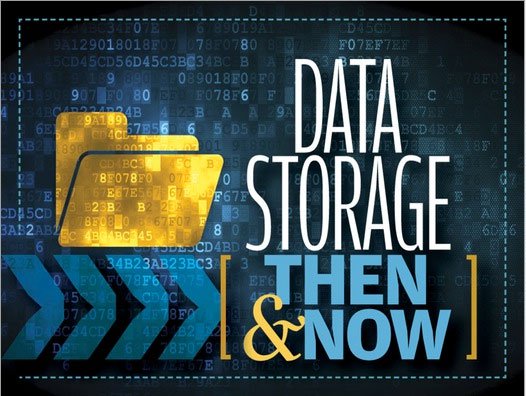 Data storage: That day and now Picture 1
Data storage: That day and now Picture 1
Meanwhile, today's desktop drives have a larger capacity: 4TB (at the end of this year it will be 5TB) enough to hold 1 million images or 562 hours of HD video. By 2020 Seagate said it will release a 60TB computer hard drive, enough to store 12 million images or 6,750 hours of HD video.
That is the development trend of storage devices, the future is how the past? In this article, we review and compare old and current storage devices.
MicroSD memory cards from 128MB up to 128GB
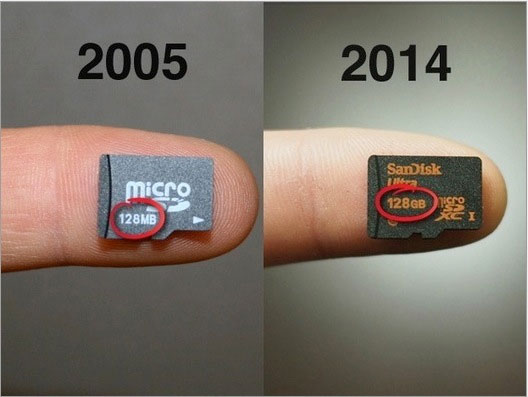 Data storage: That day and now Picture 2
Data storage: That day and now Picture 2
With increasing storage capacity (growth rate of 175% per year), NAND flash memory is still "young" and "growing" . In 1987, Toshiba announced its first NAND. . In 1995, the company introduced a 40MB memory card for cameras. Nearly 20 years later, a microSD memory card less than a fingernail with a capacity of 128 MB was born, can store more than 100 billion bytes of data. And recently, SanDisk introduced a 128 GB microSD memory card. Many of you wonder what with 128 GB of storage? That is about 32,000 songs, 27 DVD movies and up to 250,000 photos. And in the future, NAND flash memory will continue to grow and 3D NAND promises to be a good solution in the future.
HDD capacity increased by 1 million times
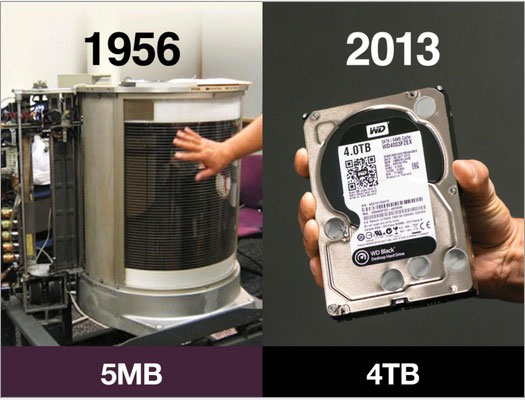 Data storage: That day and now Picture 3
Data storage: That day and now Picture 3
In 1956, IBM introduced the first HDD named RAMAC 350 (Random Access Method of Accounting and Control). RAMAC 350 has 'appearance' and 'pit' size, weighs about a ton. It has a capacity of 5MB, only "storing" an MP3 song, at a cost of about $ 1,000 per megabyte.
Today, HDDs are only 3.5-inch in size, 4TB storage capacity (5TB by the end of this year), can store up to 760,000 songs. In addition, WD's data center drive, filled with helium gas, has a capacity of up to 6TB. You think that is already very big? By 2020, Seagate expects a technology called HAMR to increase HDD capacity by up to 10 times. It means that the future HDD has a capacity of 60TB, enough to contain 15 million songs or 6,750 hours of HD video.
Storage solutions for businesses
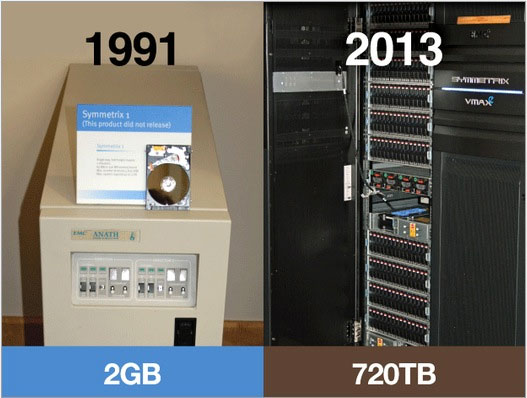 Data storage: That day and now Picture 4
Data storage: That day and now Picture 4
EMC Symmetrix serves as the first virtual server in a data building solution for companies and organizations. On the left is EMC Symmetrix 1 with 2GB capacity, on the right of EMC Symmetrix VMAX (10th generation) with 2 petabytes of capacity, 1 million times more than the first generation.
The speed is getting bigger
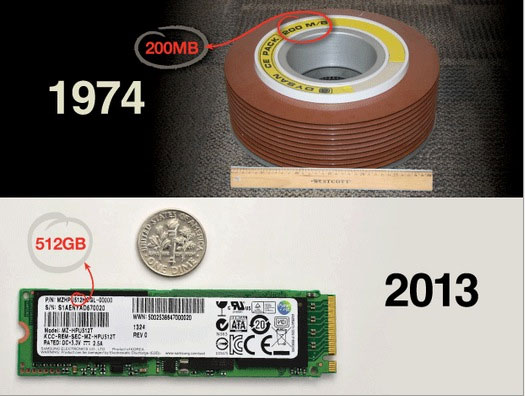 Data storage: That day and now Picture 5
Data storage: That day and now Picture 5
On the top is the Dysan Disk Pack, which was born in the 70s with a capacity of 200MB, this "plate" is 14 inches in size, weighs about 0.5kg. Disk Pack can be inserted into IBM 1311 hard drive, each disk has 20 sectors (physical area), each sector has a capacity of 100 characters and transfers data at 50Kbps. At the bottom is a Toshiba flash drive 512GB NAND PCIe standard that you can find in a mobile device, it can reach 2Gbps bandwidth with 4x PCIe 2.0.
The size is getting smaller
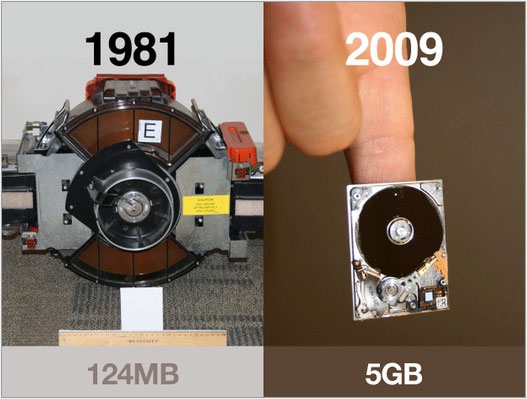 Data storage: That day and now Picture 6
Data storage: That day and now Picture 6
On the left is the RA80 drive that appeared in the 1980s, one of the first storage devices to use the platter drive (magnetic drive), 14 inches in size, 124 MB in capacity, including 30 sectors, each The sector is capable of storing 412 bytes of data. On the right is a 5GB Microdrive drive from Seagate, actually Microdrive drives launched in 1999 by 1.8 inches, 1 inch and 0.85 inches, used in MP3 players, for example. like iPod music player. Microdrive is the best example of hard drive technology that allows 'large' stuffing into a small size. Today, you can easily see 2-inch 2.5-inch computer hard drives (an average of 760GB / inch).
SSD is getting cheaper
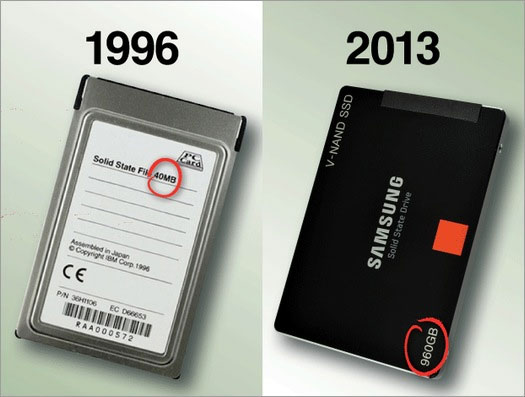 Data storage: That day and now Picture 7
Data storage: That day and now Picture 7
A few years ago solid state drives (SSDs) were very expensive, which is why it was not interested in replacing mechanical hard drives, although SSDs were much more outstanding than traditional HDDs. in terms of boot time, data access, read and write speed . Today, with technology growing at breakneck speed, SSDs tend to be cheaper and cheaper, besides SSDs in the future. Hybrid will have a capacity many times higher than the current.
Storing tape format will be 'deathly'?
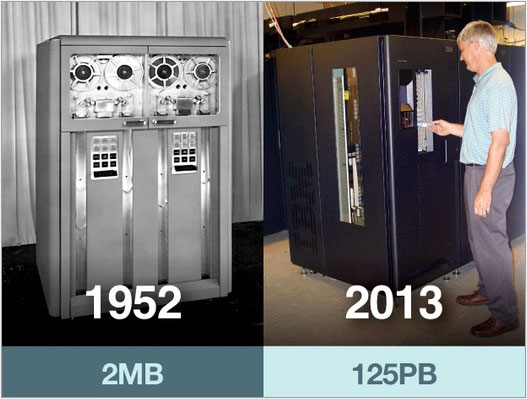 Data storage: That day and now Picture 8
Data storage: That day and now Picture 8
Magnetic tape storage (Tape) appeared in the early 50s, death knocks have been predicted many times but so far they still exist, although the popularity is not equal if not too much. Baby 'compared to disk storage.
On the left is the tape drive from IBM 726 (launched in 1952) with 2MB of storage, now computer tapes (tape cartridges) can hold up to 6TB of data, by 2022 this number is expected. is 128 TB. On the right is the IBM TS3500 (2013) tape cabinet with a capacity of up to 125PB, knowing that with just 1 PB (1024TB) you can store more than 13 years of HD video.
You should read it
- Intel and Micron cooperated to release QLC NAND memory to increase storage density
- 3 ways to increase storage capacity on Android with a microSD card
- Intel produced SSD drives shaped rulers, wanted to set a record of storage capacity
- Use BitLocker to encrypt external storage drives - Part 1
- Do you remember how the memory of your phone has been increased year by year?
- Change Storage Space in Storage Pool on Windows 10
- OneDrive is the most used cloud storage service in the enterprise
- IBM banned the use of mobile storage devices to share data
- Top 3 best memory card format software
- 8 best storage management and monitoring software
- Storage class in C / C ++
- Samsung will launch a 1TB memory chip for smartphones, will it appear on Galaxy S10?
May be interested

Use iPhone headphones to control the device

2 good tips for iOS 7 users

Instructions for using Chrome Remote Desktop application on Android

How to change the voice on Android phones

Block Android apps automatically create shortcuts automatically on the main screen

Decode the cause of the headphones ... tangled






 How to store data on Bloom for free
How to store data on Bloom for free 5 best family NAS devices for home data security, priced from 4.5 million
5 best family NAS devices for home data security, priced from 4.5 million Select the best data storage solution
Select the best data storage solution Is it good or bad for Google to store medical data in the cloud?
Is it good or bad for Google to store medical data in the cloud? The best 'cloud storage' data storage services today
The best 'cloud storage' data storage services today Build your own simple NAS system for storage needs
Build your own simple NAS system for storage needs